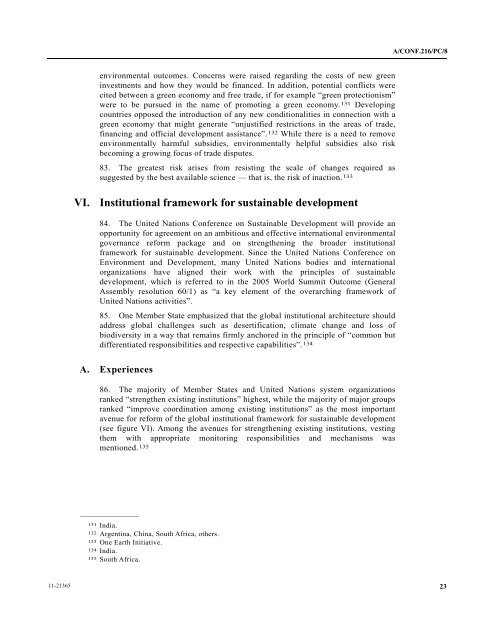General Assembly - UN Documents
General Assembly - UN Documents
General Assembly - UN Documents
You also want an ePaper? Increase the reach of your titles
YUMPU automatically turns print PDFs into web optimized ePapers that Google loves.
A/CONF.216/PC/8<br />
environmental outcomes. Concerns were raised regarding the costs of new green<br />
investments and how they would be financed. In addition, potential conflicts were<br />
cited between a green economy and free trade, if for example “green protectionism”<br />
were to be pursued in the name of promoting a green economy. 131 Developing<br />
countries opposed the introduction of any new conditionalities in connection with a<br />
green economy that might generate “unjustified restrictions in the areas of trade,<br />
financing and official development assistance”. 132 While there is a need to remove<br />
environmentally harmful subsidies, environmentally helpful subsidies also risk<br />
becoming a growing focus of trade disputes.<br />
83. The greatest risk arises from resisting the scale of changes required as<br />
suggested by the best available science — that is, the risk of inaction. 133<br />
VI. Institutional framework for sustainable development<br />
84. The United Nations Conference on Sustainable Development will provide an<br />
opportunity for agreement on an ambitious and effective international environmental<br />
governance reform package and on strengthening the broader institutional<br />
framework for sustainable development. Since the United Nations Conference on<br />
Environment and Development, many United Nations bodies and international<br />
organizations have aligned their work with the principles of sustainable<br />
development, which is referred to in the 2005 World Summit Outcome (<strong>General</strong><br />
<strong>Assembly</strong> resolution 60/1) as “a key element of the overarching framework of<br />
United Nations activities”.<br />
85. One Member State emphasized that the global institutional architecture should<br />
address global challenges such as desertification, climate change and loss of<br />
biodiversity in a way that remains firmly anchored in the principle of “common but<br />
differentiated responsibilities and respective capabilities”. 134<br />
A. Experiences<br />
86. The majority of Member States and United Nations system organizations<br />
ranked “strengthen existing institutions” highest, while the majority of major groups<br />
ranked “improve coordination among existing institutions” as the most important<br />
avenue for reform of the global institutional framework for sustainable development<br />
(see figure VI). Among the avenues for strengthening existing institutions, vesting<br />
them with appropriate monitoring responsibilities and mechanisms was<br />
mentioned. 135<br />
__________________<br />
131 India.<br />
132 Argentina, China, South Africa, others.<br />
133 One Earth Initiative.<br />
134 India.<br />
135 South Africa.<br />
11-21365<br />
23




